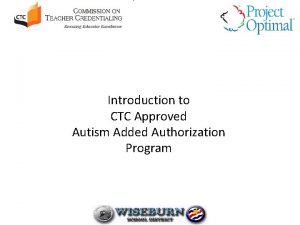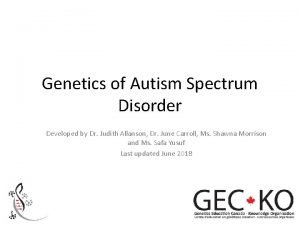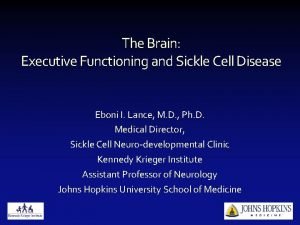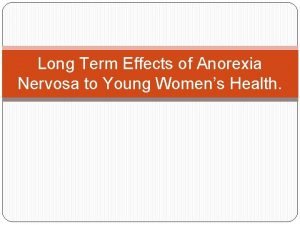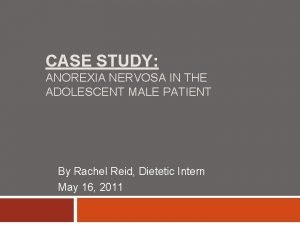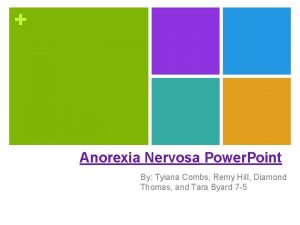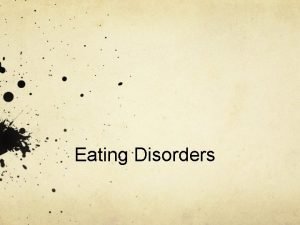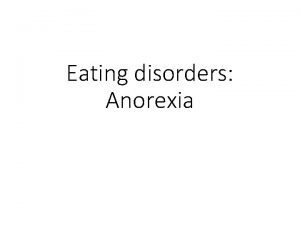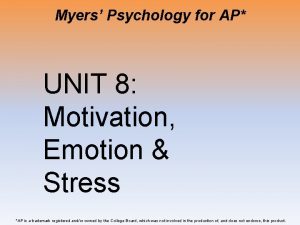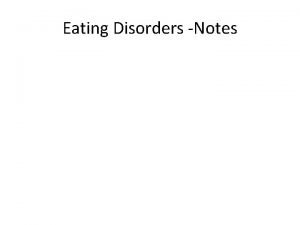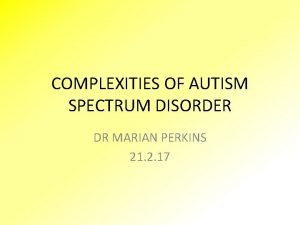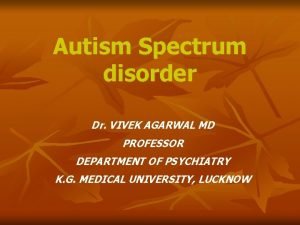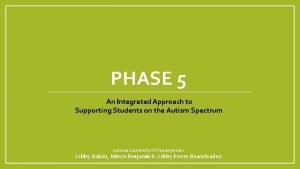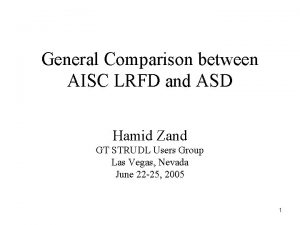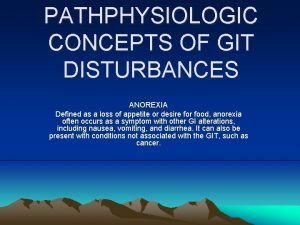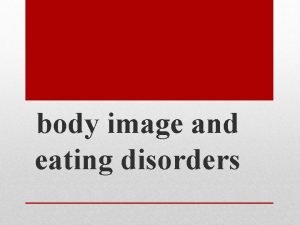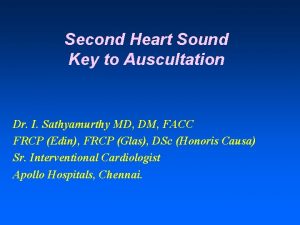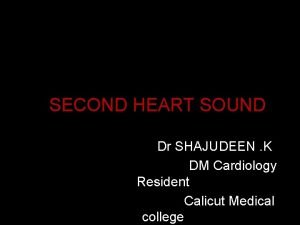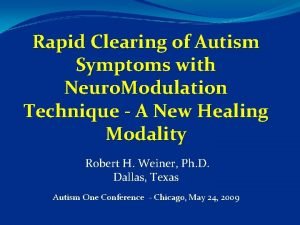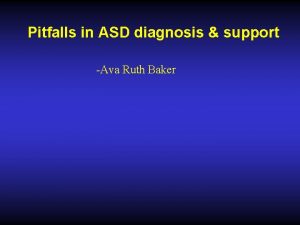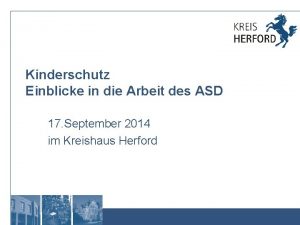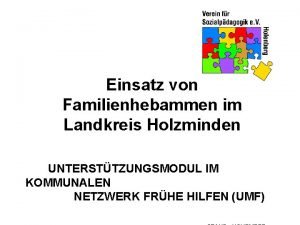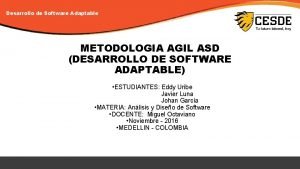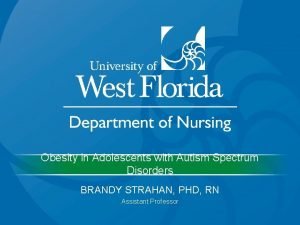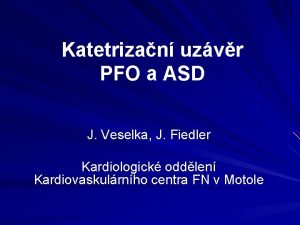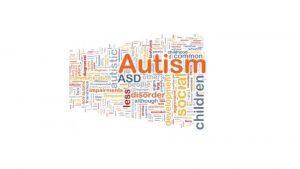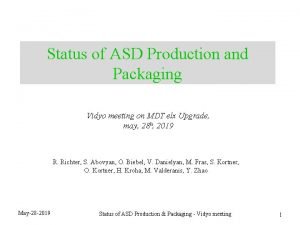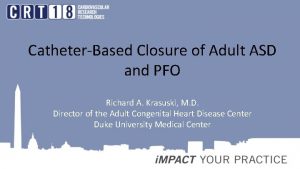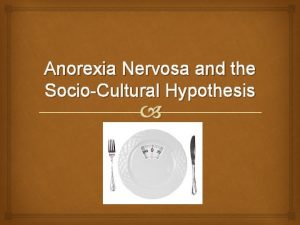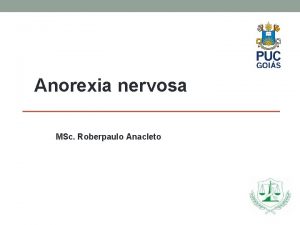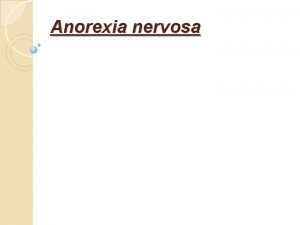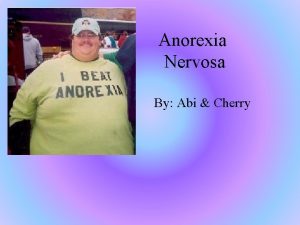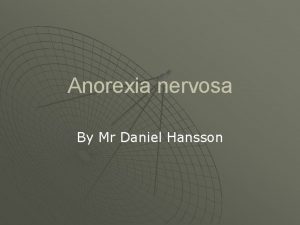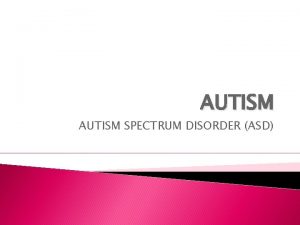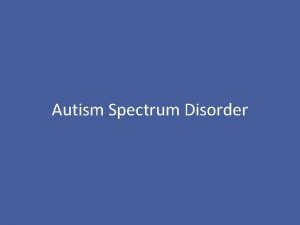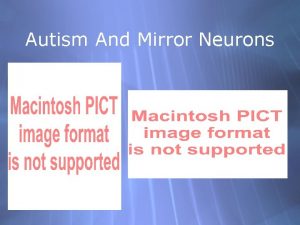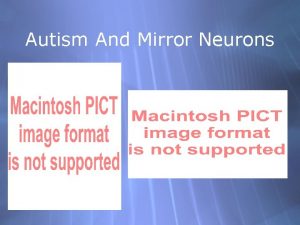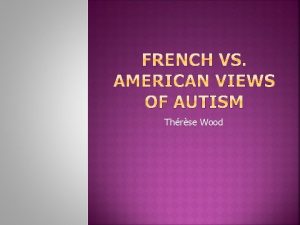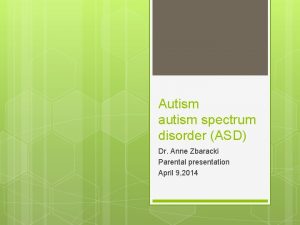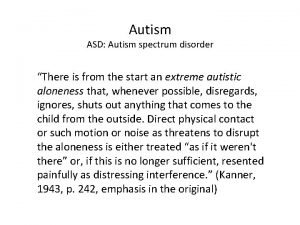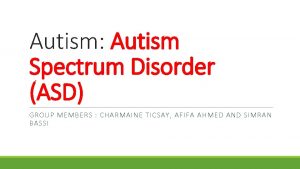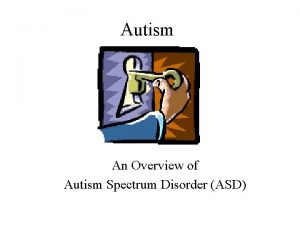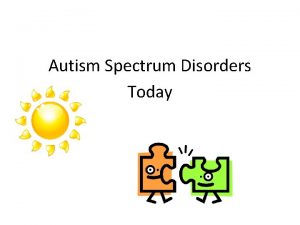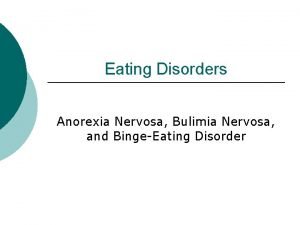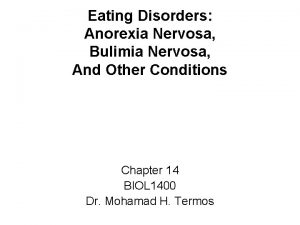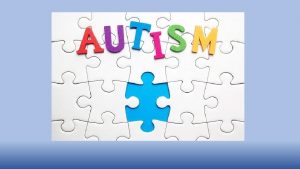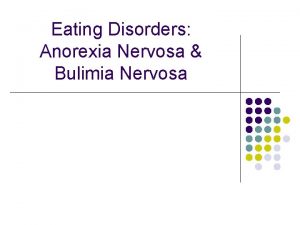Autism Spectrum Disorder ASD and Anorexia Nervosa AN


















































- Slides: 50

Autism Spectrum Disorder (ASD) and Anorexia Nervosa (AN) is there link? Kate Tchanturia, Ph. D, FBPS, FAED, FHE Professor in Psychology of Eating Disorders, Consultant Clinical Psychologist Kate. Tchanturia@kcl. ac. uk www. katetchanturia. com

Overlap? What we know from research:

The comorbidity of Eating Disorders Affective Disorder OCD spectrum EDNOS BN AN Autistic spectrum Bipolar spectrum Addiction spectrum ADHD Hollander et al 2009; Murphy et al 2010; Westwood and Tchanturia 2017

Autism Spectrum Disorder Restricted and repetitive behaviours and interests (RRBs) Social communication and interaction 2 -4 males to 1 female

Shared temperamental features AN women 34 years old with long history of AN Boy with ASD

Why we were noticing the problem? Few points: Gender bias Extreme male brain hypothesis How ASD is captured in media

Films often capture male character

Baron Cohen’s theory of exaggerated male brain Research from my lab shows: EQ IQ Hambrook et al 2012, Lopez et al 2010

ASD easier to diagnose in Males ‘hard-wired’ to systemize – Early preferences for toys which are open to being ‘systemized’ – vehicles, weapons, building blocks – Male advantage in systemizing academic subjects (Maths, Science, Technology) – Male disadvantage on e. To. M tasks but advantage on tests of systemizing – Male preponderance in jobs that require systemizing (Science, Engineering, Construction)

It is challenging to recognise ASD in Females ‘hard-wired’ for empathy: – Female newborns prefer to look at social stimuli (faces/eyes) than mechanical stimuli (mobiles) – Spontaneous female toy preferences in infancy - Dolls – Female advantage in language skills (earlier, more advanced VIQ) – Female advantage on To. M tasks – Females score higher on EQ and other E questionnaires – Female preponderance in caring professions

Camouflaging AS women and girls ‘camouflage’ their autism (Dean, Harwood, & Kasari, 2016; Rynkiewicz et al. , 2016) Mismatch between ‘external presentation’ and ‘internal state’ Compensatory behaviours – ‘social butterfly’; parallel play; eye contact (Lai et al. , 2016) Associated with greater depression and anxiety – ‘exhausting’ (Hull et al. , 2017)

Late diagnosis/special interest/hobbies • Internalising vs externalising presentation • Late diagnosis (Bargiela et al. , 2016; Begeer et al. , 2013) • Many adult women present with mental health crises prior to autism diagnosis (Gould & Ashton-Smith, 2011) Watching make up videos on You. Tube for hours

Females with ASD… Are not recognised by HCPs Do not have gender-specific diagnostic tools Are diagnosed later than males Can mask some of their difficulties – “Camouflage” Interact socially more often Have more active imaginations/engage in more pretend play • Have more gender-stereotyped, typical interests • Have a greater vulnerability to emotional difficulties • • •

Different approaches/similarities: Are autism and anorexia nervosa related? Prof C. Gillberg 1983 Sweden Is anorexia female Version of autism? Prof J. Treasure 2009 UK

Proportion of low AQ vs high AQ at admission Autism Quotient step up programme 36% 64% Non-ASD Cut off = 6. Higher scores indicating higher autistic symptomology (Tchanturia et al 2013, 2016)

Autism Diagnostic Observation Schedule (ADOS) • Semi-structured standardised measure of communication / social deficits / play associated with ASD • Series of structured and unstructured activities • Incorporation of ‘social presses’ • 2 nd version – ADOS-2 (module 4) Lord, C. , Rutter, M. , Di. Lavore, P. C. , Risi, S. , Gotham, K. , & Bishop, S. (2012). Autism diagnostic observation schedule, second edition. Torrance, CA: Western Psychological Services.

After interviewing (ADOS) 100 patients with AN (60 adults; 40 young people) we found: Autism Anorexia 35% Spectrum Nervosa Disorder Suspected ASD “Pseudo” ASD Non-ASD 17% 18% 65% Westwood et al 2017; Similar findings Betz et al 2016; Vagni et al 2016

Sensitivity of measures need further research Sedgewick et al 2019 New algorithm- more weight to the sensory sensitivities and sensory-motivated behaviours of autistic people….

Anorexia and Autism • Over-representation of ASD in AN • Poorer treatment outcomes, higher illness severity, longer illness duration • Need for treatment adaptations

Trail Making Task (TMT) Wisconsin Card Sort Task (WCST) Cognitive features: Set-shifting Tchanturia et al 2012, 2011; Brixton Task

Westwood H, Stahl D, Mandy W, Tchanturia K (2016) The set-shifting profiles of Anorexia Nervosa and Autism Spectrum Disorder using the Wisconsin Card Sorting Test: A systematic review and meta-analysis. Psychological Medicine p. 1809– 1827 doi: 10. 1017/S 0033291716000581 Overall effect size of meta-analysis, d = 0. 6 Overall effect size of meta-analysis, d = 0. 4

Attention to detail/Bigger picture: Embedded Figures Test (Lopez et al 2008, 2009; Lang et al 2014, 2015, 2016)

AN & ASD: Phenotypic similarities Behaviours Thinking Styles Co-morbidity Insistence on sameness Aloofness/Social Withdrawal Cognitive and behavioural inflexibility Narrow focus of interests Attention to detail (WCC) Co-morbid ASD in AN

ASD & AN similarities Cognitive flexibility Bigger picture thinking ASD Social cognition Theory of Mind What we can do about it? AN

Thinking Style Spectrum Global Flexible Focused AN Detailed

How people with ED think?

Set Shifting outcome:

Brixton – Cognitive Flexibility N=111 Brixton Total 14 P <. 001** 12 10 HC 8 6 4 2 0 Time 1 (N=111) Time 2 (N=66) AN High ASD 13. 18 10. 14 D 0. 52 Large effect size improvement in flexibility outcomes for low ASD traits and medium effect size for high ASD traits. Low ASD 12. 83 7. 84 D 1. 18 Tchanturia et al. , 2011. Plos One

Bigger picture thinking: Central Coherence

Individual CRT From the data with individual 10 session CRT both subgroups with AN with and without ASD have improvements in SS and CC medium to large effect sizes. SS d= (H) 0. 8 -(L)1. 0 CC d= (H)0. 5 - (L)0. 2

Examining Research Based Treatment Outcomes CRT and CREST ASD Individual CRT and CREST (10 sessions) Non-ASD Both group and individual CRT and CREST facilitates changes

High ASD patients don’t respond to group format as effectively …but do respond well to individual format CRT • I liked the interactive nature of • Interacting and discussing the group. The variety of tasks instead of being talked at, kept my attention because otherwise you lose your conversation. • The playful and curious • Relaxed, informal & a approach to psychological comfortable length in duration intervention. There is no fun & challenging. right or wrong. It lightens the load off therapy and makes it fun. ASD Non ASD

What about CRT and ASD Limited evidence: Okuda et al (2017) Feasibility of cognitive remediation therapy for adults with autism spectrum disorders: a single-group pilot study CRT improved CC and anxiety scores for individuals with ASD, suggesting that CRT is an effective treatment for individuals with ASD.

“Hot” Cognition/Emotion regulation Emotional processing Poor recognition of own Decision making CREST Poor recognition of others Case series Poor expression Positive emotions/ communication

In addition to CRT we are developing emotion regulation strategies for ASD/AN comorbidity

What we know and what we can explore to minimize the GAP between research and clinical practice? • CRT-in both forms well liked by patients with and without ASD. • CRT is useful for engagement, communication. • CRT improves cognitive outcomes. • We need more work on emotion regulation couching • We can do better to address sensory sensitivities • Dietary requirements….

Sadly some clinicians don’t hear voices from patients who experience both ASD and ED • “Last year my mum, across an Aspergers article and said it sounded like me. I went to the GP and got a referral for an NHS ASD assessment for 8 months later. I had assessment earlier this year, it was very brief and I was dismissed because I had already been diagnosed with Anorexia. I then aid for a private assessment from a psychologist and spent 5 hours being assessed. I was then diagnosed with Aspergers. I then with this in mind started outpatient treatment. • I have always been highly anxious and obsessive and now with my low weight my Autistic traits have been exacerbated. ” • “…. leave autism at the door”….

What can we do about it? Patients (AN/ASD) Qualitative interviews Carers Clinicians


Steps of Implementation • • • 1. Screening 2. Dietetics 3. Physical Adaptations 4. Clinician Training and Support 5. Adapting interventions and developing psychoeducation materials

Dietetics - “Beige” menu - Main goal is get those calories in Learning Points: - ED patients will get anxious over and change to do with foodespecially choice!! - Competition with ‘special treatment’ - Pictures! - Patients might need other things care planned

Physical Adaptations Learning Points: Key Covers ‘Going easy on the walls’ Pastel/ neutral wall colours and blinds - Doing this on a weekend - Resistance: The dislike of ‘special treatment’- get everyone involved! Ward Flooring De-cluttered

Treatment Adaptations “The combination of autism and starvation is like autism on steroids” 01 Literal language 03 02 Longer processing time (more sessions) Written communication 04 Focus on thinking styles, not thoughts 05 Separate autism from the MH condition (incorporate special interests)

Thanks to For manuals and more information visit: www. katetchanturia. com Research gate If we have time for questions? If not email me: Kate. Tchanturia@kcl. ac. uk

BEACON Brain imaging study Aim One Differences in brain structure Aim Two Neural processes underlying difficulties in • Central coherence (EFT) • Theory of mind (Triangle animations) • Implicit emotion processing (Ekman faces) Aim Three The impact ASD symptoms have on these difficulties

Recent publications from our group: • • • Dandil Y, Smith K, Adamson J, Tchanturia K (2019) Individual Cognitive Remediation Therapy Benefits for patients with Anorexia Nervosa and High Autistic features European Eating Disorder Review. Kinnaird E, Norton C, Pimblett C, Stewart C, Tchanturia K (2019) Eating as an autistic adult: an exploratory qualitative study Plos one; 29; 14(8): e 0221937. doi: 10. 1371/journal. pone. 0221937 Sedgewick F, Kerr- Gaffney J, Leppanen J, Tchanturia K (2019) Anorexia nervosa, autism, and the ADOS: how appropriate is the new algorithm in identifying cases? Front Psychiatry Doi: 10. 3389/fpsyt. 2019. 00507 Sedgewick F, Leppanen J, Gog F, Hayward H, Happe F, Tchanturia K (2019) Tricky triangles: similarities and differences in Theory of Mind responses of patients with anorexia nervosa with and without autistic features. Frontiers in Psychiatry. doi: 10. 3389/fpsyt. 2019. 00318 Sedgewick F, Leppanen J, Tchanturia K (2019) Autistic adult outcomes on weight and Body Mass Index: a large-scale online study; Eating and Weight Disorders - Studies on Anorexia, Bulimia and Obesity. EAWD-D-19 -00098 R 2 doi: 10. 1007/s 40519 -00695 -8. Kerr-Gaffney J, Harrison A, Tchanturia K (2019) Cognitive and Affective Empathy in Eating Disorders: A Systematic Review and Meta-analysis. Frontiers in Psychiatry https: //doi. org/10. 3389/fpsyt. 2019. 00102 Adamson J, Ozenc C, Baillie C, Tchanturia K (2019) Efficacy of a Self-Esteem Group for Inpatients with Anorexia Nervosa Special Issue "Psychotherapeutic Treatment for Anorexia Nervosa" in Brain Sciences doi: 10. 3390/brainsci 9010012 Kinnaird E, Stewart C, Tchanturia K (2019) Investigating alexithymia in autism: a systematic review and metaanalysis; European Psychiatry; 3; 55 : 80 -89 doi: 10. 1016/j. eurpsy. 2018. 09. 004. Kinnaird E, Norton C, Stewart C, Tchanturia K (2019) Same behaviours, different reasons: what do patients with cooccurring anorexia and autism want from treatment? International Review of Psychiatry, 31(4): 308 -317 10. 1080/09540261. 2018. 1531831

References Kerr- Gaffney J, Harrison A, Tchanturia K (2018) Social anxiety in the eating disorders: A systematic review and meta-analysis. Psychological Medicine Adamson J, Leppanen J, Murin M, Tchanturia K. (2018) Effectiveness of Emotional Skills Training for Patients with Anorexia Nervosa with Autistic Symptoms, Group or Individual Format European Eating Disorder Review. Adamson J, Leppanen J, Tchanturia K. (2018) Impact of cognitive remediation therapy on neurocognitive processing in anorexia nervosa. Frontiers in Psychiatry-Psychopathology Cardi V, Tchanturia K, Treasure J (2018) Premorbid and illness-related social difficulties in eating disorders: an overview of the literature and treatment developments. Current Neuropharmacology; Tchanturia K, Larsson E, Adamson J. (2016) How anorexia nervosa patients with high and low autistic traits with respond to group Cognitive Remediation Therapy; BMC Psychiatry; Tchanturia K, Larsson E, Adamson J (2016) Brief group intervention targeting perfectionism in adults with anorexia nervosa: empirically informed protocol; European Eating Disorders Review DOI: 10. 1002/erv. 2467 Westwood H, Stahl D, Mandy W, Tchanturia K (2016) The set-shifting profiles of Anorexia Nervosa and Autism Spectrum Disorder using the Wisconsin Card Sorting Test: A systematic review and meta-analysis. Psychological Medicine p. 1809– 1827 doi: 10. 1017/S 0033291716000581 Sparrow K, Tchanturia K (2016) Inpatient brief group therapy for anorexia nervosa: Patient experience. International Journal of Group Psychotherapy. DOI: 10. 1080/00207284. 2016. 1156406 ISSN- 0020 -7284 print/1943 -2836 online Davies H, Wolz I, Leppanen, F Fernandez Aranda, U Schmidt, Tchanturia K (2016) Facial expression to emotional stimuli in non-psychotic disorders: A systematic review and meta-analysis. Neuroscience & Biobehavioral Reviews; S 0149 -7634(15)30237 -210. 1016/j. neubiorev. 2016. 02. 015 Westwood H, Eisler I, Mandy W, Leppanen J, Treasure J, Tchanturia K (2016) Using the Autism-Spectrum Quotient to measure Autistic Traits in Anorexia Nervosa: A systematic review and meta-analysis. Journal of Autism and Developmental Disorders 46(3): 964 -77; 10. 1007/s 10803 -015 -2641 -0 13: 1 -23 Dapelo M, Bodas S, Morris R, Tchanturia K. (2016) Deliberately generated and Imitated Facial Expressions of Emotions in people with Eating Disorders. Journal of Affective Disorders. 191; 1– 7 10. 1016/j. jad. 2015. 10. 044 191: 1 -7

References (cont) Selected references used in the presentation Tchanturia K, Lounes N, Holttum S (2014) Cognitive remediation in anorexia nervosa and related conditions: A systematic review. European Eating Disorders Review 22(6): 454 -62; DOI: 10. 1002/erv. 2326 Mandy W, Tchanturia K (2015) Do women with eating disorders who have social and flexibility difficulties really have autism? A case series. Molecular Autism. 6 (6) doi: 10. 1186/2040 -2392 -6 -6 Lang K, Roberts M, Lopez C, Goddard E, Khondoker M, Treasure J, Tchanturia K; An investigation of central coherence in eating disorders: A synthesis of studies using the Rey Osterrieth Complex Figure Test; Plos one Kyriacou O, Easter A, Tchanturia K (2009) Comparing views of patients, parents and clinicians on emotions in anorexia: A qualitative study. Journal of Health Psychology. 14(7) 843– 854 Whitney J. Easter, A. Tchanturia K (2008) Service users' feedback on cognitive training in the treatment of anorexia nervosa: a qualitative study. International Journal of Eating Disorders; 41(6): 542 -50 Lang K, Marin Dapelo M, Khondoker M, Morris R, Treasure J, Tchanturia K (2015) Exploring emotion recognition in adolescents and adults with anorexia nervosa using a body motion paradigm. Eur Eat Disord Rev. 22. 23(4): 262 -8 doi: 10. 1002/erv. 2358 Doris E, Westwood H, Mandy W, Tchanturia K (2014) Patients with Anorexia Nervosa show similar friendships difficulties to people with Autism Spectrum Disorders: A Qualitative Study. Psychology Special issue Autism. 5, 1338 -1349 Hambrook D, Schmidt U, Russell T, Treasure J, Tchanturia K (2008) Empathy, Systemizing, and Autistic Traits in Anorexia Nervosa: A Pilot Study British Journal of Clinical Psychology 47, 335 -339 Tchanturia K, Happe F, Godley J, Bara – Carill N, Treasure J, Schmidt U. (2004) Theory of Mind in AN. European Eating Disorders Review 12, 361 -366


CREST has focus on psych education materials from Positive psychology, homework, specific exercises
 Autism authorization programs in california
Autism authorization programs in california Types of autism spectrum disorder dsm 5
Types of autism spectrum disorder dsm 5 Rare types of autism
Rare types of autism Autism spectrum disorder
Autism spectrum disorder Autism spectrum disorder adhd
Autism spectrum disorder adhd Unit 3 nutrition lesson 6 anorexia nervosa and bulimia
Unit 3 nutrition lesson 6 anorexia nervosa and bulimia Long term effects of anorexia nervosa
Long term effects of anorexia nervosa Case study on anorexia nervosa
Case study on anorexia nervosa Bulimia nervosa ppt
Bulimia nervosa ppt Anorexia nervosa
Anorexia nervosa Anorexia nervosa syptoms
Anorexia nervosa syptoms The diagnostic term anorexia nervosa literally means
The diagnostic term anorexia nervosa literally means Anorexia nervosa definition wikipedia
Anorexia nervosa definition wikipedia Unit 8 myers ap psychology
Unit 8 myers ap psychology Anorexia nervosa is characterized
Anorexia nervosa is characterized Puberty and autism spectrum disorders
Puberty and autism spectrum disorders Social pragmatic communication disorder vs autism
Social pragmatic communication disorder vs autism Explain electronic configuration of cu and cr
Explain electronic configuration of cu and cr Factitious disorder vs somatic symptom disorder
Factitious disorder vs somatic symptom disorder Fetal alcohol spectrum disorder
Fetal alcohol spectrum disorder Spectrum disorder
Spectrum disorder Spectrum disorder
Spectrum disorder Absorption spectrum vs emission spectrum
Absorption spectrum vs emission spectrum Difference between lrfd and asd
Difference between lrfd and asd Anorexia and stomach ulcers
Anorexia and stomach ulcers Anorexia and bulimia venn diagram
Anorexia and bulimia venn diagram Anorexia, nausea and vomiting
Anorexia, nausea and vomiting Asd
Asd Reverse split s2
Reverse split s2 Fixed split s2 causes
Fixed split s2 causes Atec checklist
Atec checklist Ava ruth baker
Ava ruth baker Jugendamt hiddenhausen
Jugendamt hiddenhausen Landkreis holzminden jugendamt
Landkreis holzminden jugendamt Asd metodologia
Asd metodologia Tetralogy of fallot xray
Tetralogy of fallot xray Asd college college readiness program
Asd college college readiness program Asd 3000l
Asd 3000l Asdaha
Asdaha Simplified technical english examples
Simplified technical english examples Ostium secondum
Ostium secondum Secundum asd
Secundum asd Asd brandy
Asd brandy Asd crystel b
Asd crystel b Uzvr
Uzvr Arcene bmw
Arcene bmw Asd
Asd Asd
Asd Asd
Asd Teacher info sheet
Teacher info sheet Dvd
Dvd
